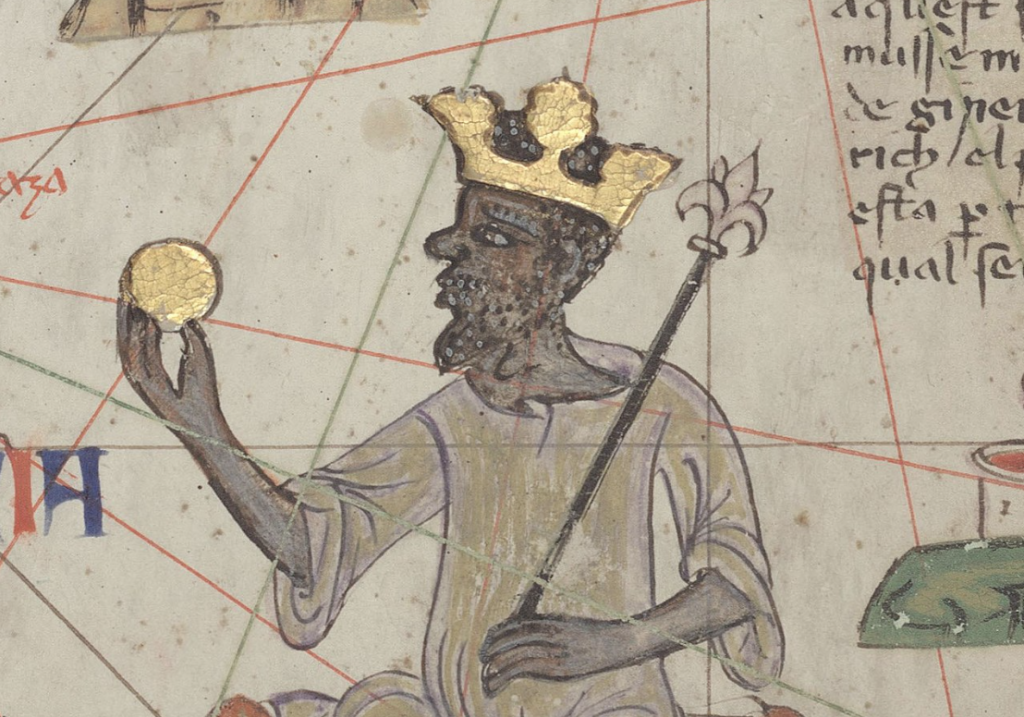Last updated on October 20th, 2023 at 09:34 pm
Mansa Musa, the richest man in the world, was a mighty emperor of the Malian Empire who reigned during the 14th century. During his rule, he made many contributions to Mali and its people.

How Mansa Musa became the emperor of Mali
After hearing about Mansa Musa, one may assume that the man was simply born into a wealthy family or had some sort of lucky streak when it came to acquiring his wealth. However, Mansa Musa’s story is much more interesting than that.
Mansa Musa was born around 1280 CE in the empire’s capital of Niani. When Mansa Musa was old enough, he became a deputy allowing him to serve as the interim ruler of Mali if anything should happen to the ruler. Musa wasn’t randomly chosen to serve the emperor. His great-uncle was Sundiata Keita, the founder of the Mali Empire.
As it happens, the current ruler, Muhammad ibn Qu, was obsessed with learning more about the Atlantic Ocean and what lay beyond it. So, according to a historian known as Shibab al-Umari, the emperor went on an expedition with approximately 2,000 ships and thousands of men, women, and slaves.
The journey set sail but reportedly never returned; sources are unclear about what happened to the emperor. With Mali currently without an emperor, Musa was tasked with assuaging the people and ruling in Abu-Bakr II’s stead. As a result, Musa inherited the kingdom and all the wealth and power that came with it.
Mansa Musa’s wealth
Mansa Musa was extremely wealthy, even by today’s standards. He had a personal fortune of around $400 billion, making him the richest man in history. That’s more than twice as much as Bill Gates and Jeff Bezos are worth today. Most of his wealth came from the empire’s abundant gold and salt mines.
In addition, he grew his wealth through personal endeavors, such as trading and mining gold from the empire’s reserves and selling ivory from Elephants. He was estimated to have owned half of all the world’s gold when he passed.
Mansa Musa also owned vast tracts of land, livestock herds, and thousands of slaves. The Malian Empire held some of Africa’s most prosperous trading centers. Cities such as Timbuktu and Gao served as critical stops along the trans-Saharan trade routes.
These cities were filled with merchants from all over the world who came to buy and sell various goods, including gold, salt, slaves, Kola nuts, ivory, and spices.
While Mansa Musa defended the trade routes from bandits, he grew wealthier as he controlled the routes themselves. He taxed the merchants who used the roads and, in turn, used that money to finance his extravagant lifestyle and public works projects throughout Mali.
Mansa Musa’s infamous pilgrimage to Mecca
Mansa Musa was a generous ruler who made many contributions to Mali during his reign. While he remained enormously wealthy in his own right, he wasn’t well known outside of the Mali Empire.
Whether this notion influenced his later decisions is unknown, but in 1324, Mansa Musa decided to make his pilgrimage to Mecca. In the same fashion as his predecessor, Mansa Musa would not go alone.
He took an entourage of 60,000 men and 12,000 slaves with him on his journey. Historical sources mention that even the slaves wore gold and Persian silk, and each slave carried a staff of gold weighing around six pounds.
The procession also brought along approximately 80 camels laden with 300 pounds of gold each. Needless to say, this pilgrimage was quite the sight as he made the nearly 4,000-mile journey.
Mansa Musa gave out alms to the poor and built mosques wherever he stopped. He was so generous with his wealth that he caused inflation to skyrocket in Cairo and Medina due to the sudden influx of gold into those economies. Historical documents said that Cairo didn’t recover from his visit until 12 years later.
During his pilgrimage, he honored his faith, but he also used it as an opportunity to expand the Mali Empire. He acquired the territory of Gao, and by the end of his reign, the empire included what is now modern-day Senegal, Gambia, Guinea, Chad, Nigeria, Niger, and Mauritania.
While on his pilgrimage, he built mosques and universities, and his generous patronage of scholars and artists made him one of the most learned rulers in Africa.
In addition, he was instrumental in developing Timbuktu as a center of learning; when he returned from his pilgrimage, he brought architects, masons, and scholars from Cairo and Medina. They helped Timbuktu become a prosperous trading city and a hub for major Islamic universities in Africa.
Mansa Musa’s legacy
Mansa Musa passed in 1337 during his return trip from Mecca. While the cause is unknown, it’s believed that he may have contracted an illness while on his journey.
Despite never visiting, stories of his wealth reached Europe. The Catalan Atlas, created in 1375 by Spanish cartographer Abraham Cresques depicted him wearing a gold crown, gripping a gold scepter, and holding an enormous golden nugget, which was likely exaggerated.
Even though Mansa Musa only ruled for 20 years, he left a lasting impression on the world. He was an immensely wealthy man who used his wealth to benefit others. In addition to his religious pilgrimage, he built schools, libraries, and hospitals throughout Mali. His legacy continues centuries after his death in Mali’s mosques, universities, and culture.

